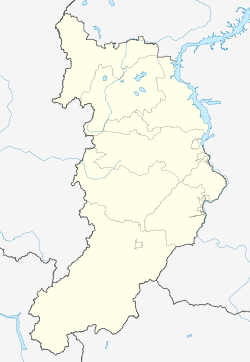Abasa (city)
| city
Abasa
Абаза
|
||||||||||||||||||||||||||||||||||||||||
|
||||||||||||||||||||||||||||||||||||||||
|
||||||||||||||||||||||||||||||||||||||||
| List of cities in Russia | ||||||||||||||||||||||||||||||||||||||||
Abasa ( Russian Абаза́ , abbreviation of «Абака́нский Заво́д» / Abakanski Sawod = Abakan plant ) is a city in Khakassia (central southern Siberia , Russia ) on the Abakan River . It is located about 150 km southwest of the republic capital Abakan and has 17,115 inhabitants (as of October 14, 2010). The village was founded in 1856 to mine iron ore (interrupted 1926–1957) and has had town status since 1966. In their vicinity, wide steppes spread out, which are bordered by the mountain ranges of the Sajan with its taiga forests. This is one of the most remote areas of Khakassia.
geography
Abasa is at the starting point of the 250 km long mountain road to Tuwa , one of only two connecting roads that lead into this remote republic. One runs from Abakan via Abasa through the gorges of the West Sayan Mountains and over the Sajanski Pass at an altitude of 2206 m to Ak-Dowurak in Tuwa. The other leads from Abakan via Nizhny Suetuk, a Cossack village founded in 1740 , through the Eastern Sayan Mountains to the Tuvinian capital, Kyzyl .
The Abakan River near Abasa only carries an average water volume of 35 m³ / s in March (minimum monthly average 13 m³ / s). After the snowmelt in the Sajan, the water masses swell to an average of 918 m³ / s in June (maximum June average even 2050 m³ / s). A bridge was swept away by a flood in 2000 and the connection to Tuva was interrupted.
Population development
| year | Residents |
|---|---|
| 1959 | 11,646 |
| 1970 | 15.202 |
| 1979 | 15,818 |
| 1989 | 17,630 |
| 2002 | 18,052 |
| 2009 | 17,115 |
Note: census data
economy
In the 1950s a new metallurgical combine was built and the area was connected to the Kuzbass region via a railway line . At the same time, the road connection was established, which today leads over the Sayansky Pass to the asbestos mines of Ak-Dovurak and on to Kyzyl .
Abasa has a typical iron ore deposit, the main minerals of which are magnetite and hematite and in which garnet occurs as a non -ore mineral . Chalcopyrite , pyrite and epidote are also stored here as accompanying minerals . This deposit was already known in the Iron Age and it has been industrially exploited since the middle of the 19th century. The iron content of the ore is over 40%. In 1988 ore extraction reached 3.5 million tons.
Individual evidence
- ↑ a b Itogi Vserossijskoj perepisi naselenija 2010 goda. Tom 1. Čislennostʹ i razmeščenie naselenija (Results of the All-Russian Census 2010. Volume 1. Number and distribution of the population). Tables 5 , pp. 12-209; 11 , pp. 312–979 (download from the website of the Federal Service for State Statistics of the Russian Federation)
- ↑ Abasa 1932-99 gauge at r-arcticnet , accessed on January 20, 2013
Web links
- Abasa on mojgorod.ru (Russian)



